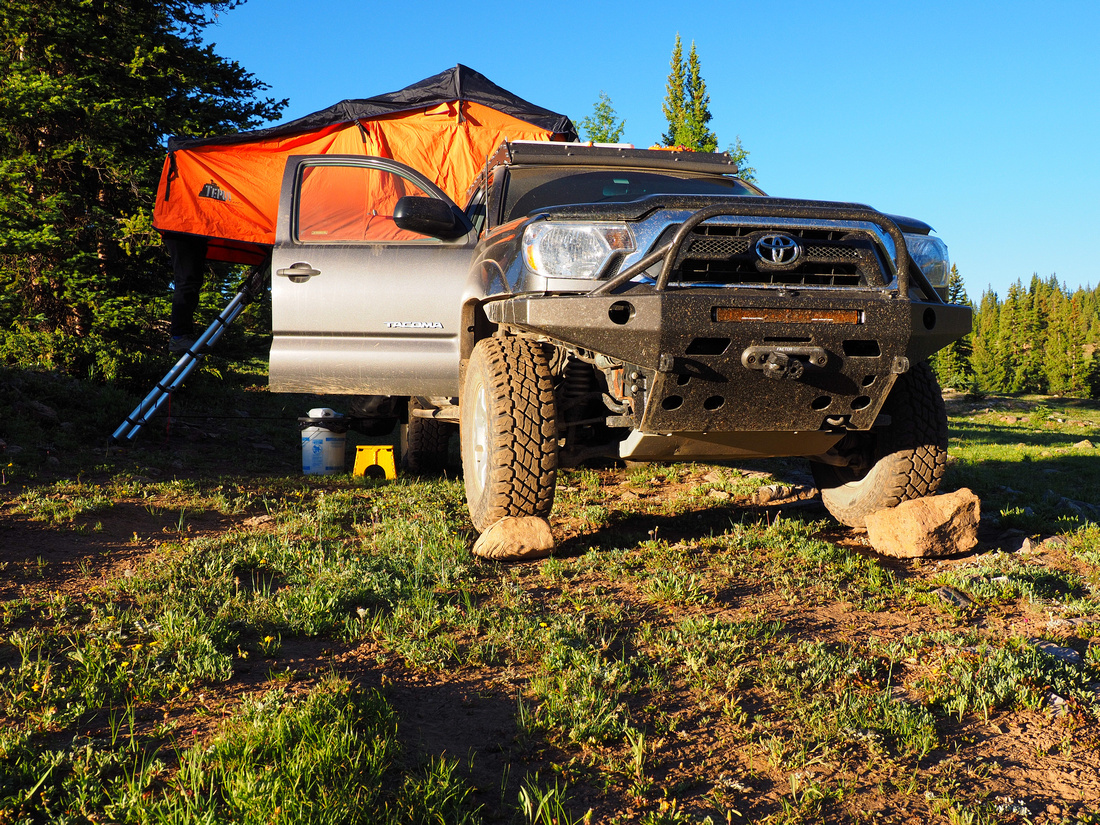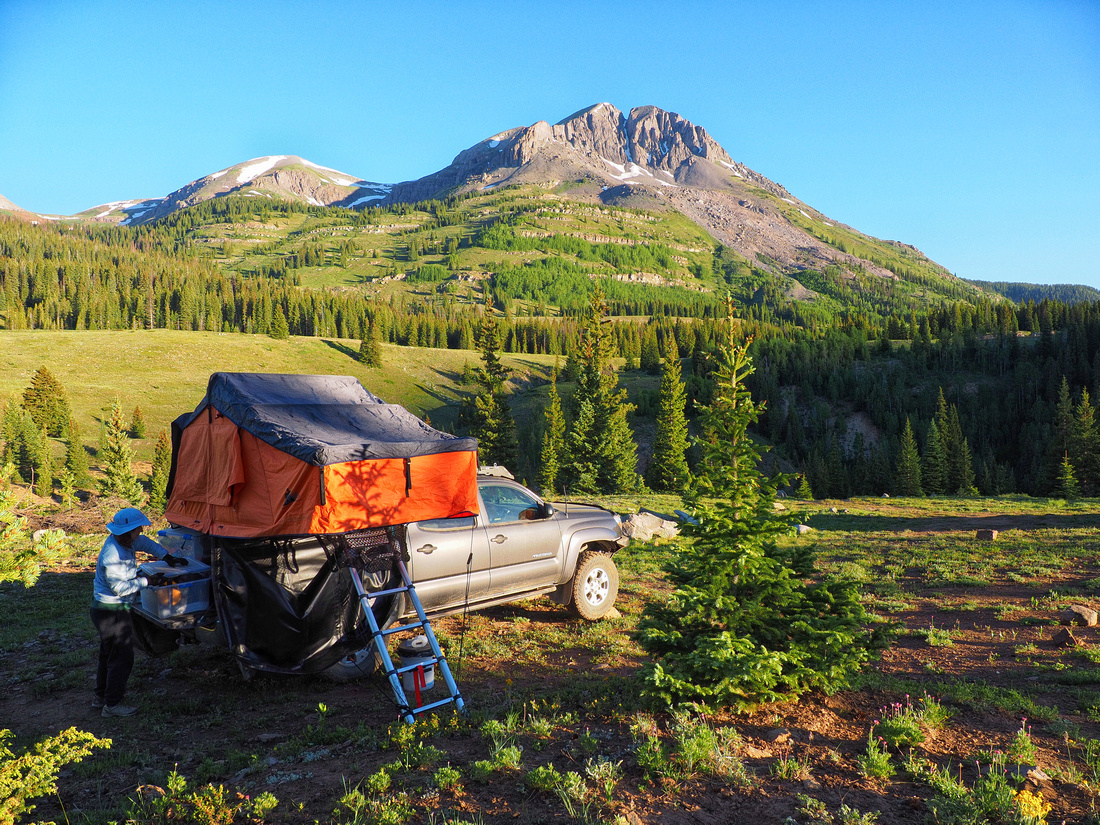Roof Top Tents: Setup & Packing
Difficulties of setting up & packing a Roof Top Tent are worth considering if you're in the market for one. If you've streamlined the process, it's no problem. I make an effort to keep things to a minimum inside the RTT, which makes it much easier for me to get on with whatever else I want to do. I only have experience with a Tepui Tents Autana Ruggedized, so other makes and models may differ.
Exterior setup: Unzip the cover, release straps, extend ladder, use ladder to leverage the tent open, adjust ladder, insert window rods (if used) & vestibule U-pole, loop vestibule guy lines to ladder feet - I've never bothered to stake the lines properly. Load the tent with whatever is lacking, and you're done. Rolling up the cover is optional. If leveling is required, it's usually not that hard.

 Here's a Tepui Tents video that covers setup. Many folding RTTs will operate similarly. Skip ahead to 5:13 for the setup portion.
Here's a Tepui Tents video that covers setup. Many folding RTTs will operate similarly. Skip ahead to 5:13 for the setup portion.
Interior setup: I leave two flat sheets inside the RTT; one to sleep on, one to sleep under. In a weathertight storage bin, stored in stuff sacks, I keep a down comforter, sleeping bags (not always needed), and pillows, with a light dedicated to RTT use. Using stuff sacks also protects the bedding in case of precipitation. Once the RTT is popped up, all of the bin contents go inside, along with any clothes, books, etc. that may be needed for the night. In the morning, everything returns to stuff sacks and is positioned by the RTT door, so it can be returned to the bin quickly from outside.
Packing: Wake up, stuff bedding in sacks, get dressed, close windows, put everything inside by the tent door, and out I go. Remove window rods (if used), remove vestibule U-pole (not all tents have one), fold tent closed, stow ladder/U-pole/rods on top of tent, stuff tent fabric in sides, tighten side straps, pull cover over folded tent, zip cover closed, apply cover straps.
Common Problems: Two common sources of problems come from trying to squeeze too much bedding inside the RTT when packing it, and from loading too many things inside while trying to use it. I experienced both early on, and learned that avoiding those problems increased my satisfaction with the tent. Storing extra bedding inside seems like a good idea, but if it causes the tent to become difficult to collapse, zipping up the cover can become a real chore. It's better to store bedding separately and avoid that fight, in my opinion. The other problem develops when too many extras are loaded inside, leading to cramped quarters and more time spent setting up and taking down the tent. It's easy to waste time fiddling with many individual items. A better solution would be to keep tent items in a single small bag so there's only one more thing to move in & out.
With my tent, setup is quick in any weather I've experienced (high wind, rain, snow). In high wind, I've attached a load strap from my truck to the free side of the floor to stabilize it a bit, along with one from the truck to the base of the ladder. I take out the slack, but don't tighten the straps much. I've only had to do this once during a very gusty night in North Dakota. I have an annex and weatherhood, but haven't used them yet. The next time I have a winter base camp, I'll give both a try.

I also use a small, folding step stool and my truck's sliders for better access when working on the RTT. As for the perils of bad weather, I don't have to spend much time outside, and I have the appropriate clothing anyway. I don't believe there's much physical effort required, but setting up an RTT is more taxing than climbing into a travel trailer or RV. The most demanding task is opening & closing the tent, and that's made easier if the ladder is fully extended, and/or two people work the ladder together.
The more you go through the process, the faster it gets. An RTT isn't the right shelter for everyone and every condition, but I find mine to be a very useful, comfortable option when I'm staying with my truck for the night. Nothing above is innovative, but after many confused conversations about my RTT, I don't believe that the simplicity of setup & packing is immediately apparent to everyone.


Comments
I've also thought about building a true overland camper, but that takes a level of time & money that I can't see myself dedicating to the project for some time. That also gets away from keeping a light footprint so I can still use the same vehicle for most 4WD trails.
I've thought of doing this myself, as the campervan doesn't get a lot of use nowadays, but a trailer is essential for us. We've done a couple of trips now where we just take the trailer and a tent (as a backup), while looking at staying in a hut for a few days. What's a negative about the campervan is that you have to open it fully so that it can be packed and that can't be done inside our garage.
Can you please send me a photo/video of how that bottle works when you need to do No2 in the middle of the night. :)
The Nalgene Cantene is an excellent, reusable pee bottle. https://store.nalgene.com/Cantene-32oz-p/2575-0032.htm
I've used the same one for several years, backpacking & car camping. My friends used to make disparaging comments about it, but soon began using them, too. It's so much better than getting out in the weather for a piss.